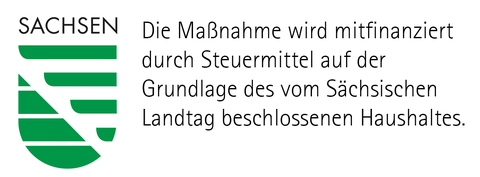HyBau
Energy self-sufficient, CO2-neutral construction site
| Financing: | Sächsische Aufbaubank - development bank - (SAB) |
| Funding code: | 100694137 |
| Duration: | 04/2024 - 03/2025 |
| Contact: | Lukas Trommler |
Motivation and problem definition
Today, the power supply of mobile construction machinery is largely based on combustion engines, in which the chemical energy bound in liquid fuels is used to provide mechanical power. With its energy concept, the German government has formulated the central goal of achieving greenhouse gas neutrality by 2045. In general, a trend towards CO2-reducing measures through alternative drive technologies can therefore be observed in all industrial sectors, which are implemented in different ways depending on the application-specific requirements.
The need for and commitment to electromobility in Germany is also becoming increasingly noticeable in the more conservative mobile machinery sector (which relies on tried-and-tested solutions), with the result that construction machinery and system manufacturers are beginning to offer hybrid and electrified drive concepts. For machines in the low power range (< 50 kW), batteries are generally used as energy storage systems. For construction machinery in larger power classes, the use of hydrogen as an energy source and fuel cells as energy converters can bridge the gap between modern battery technology and alternative eFuel technology.
An important prerequisite for the future operation of battery-electric and hydrogen-based construction machinery is the local supply and refueling infrastructure on the construction site. To this end, decentralized mobile charging and refuelling systems must be established, similar to the refuelling of construction sites using diesel tankers. Construction sites that cannot be supplied with electricity or hydrogen via the power grid due to their location pose a particular challenge. This applies, for example, to construction projects on greenfield sites, on freeways or in unpaved terrain. Here it is necessary to enable self-sufficient energy and hydrogen production directly on site (see figure). One possible solution is to set up and operate a local microgrid. This generates the necessary energy on the construction site - e.g. through photovoltaics or small wind turbines - and converts it into hydrogen using an electrolyzer. On the one hand, this can be used directly in the machines (fuel cell or hydrogen combustion engine) to provide the mechanical power. On the other hand, the energy can be temporarily stored in tanks in the form of hydrogen if no active consumers are available. At the same time, the microgrid offers the possibility of directly operating electrically powered consumers or charging machine batteries.

Energieautarke Baustelle mittels Microgrid
The aim of the project is a feasibility study on local energy and hydrogen supply on construction sites. The study is intended to demonstrate the potential and opportunities of an energy self-sufficient and CO2-neutral construction site. The feasibility of an energy self-sufficient construction site is to be investigated through the collection and management of construction site data and the integration of various energy concepts. The central concept is a microgrid with electrolysis for hydrogen production and fuel cells for reconversion into electricity. It is important to develop an efficient and sustainable energy management system that meets the specific requirements of construction sites and contributes to the reduction of CO2 emissions.

